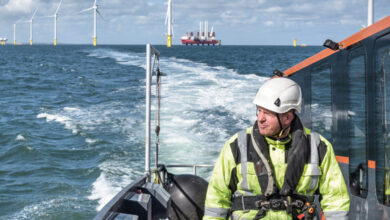Energy regulation: Policy, practice and the feedback loop
 Shane Lynch, Chief Executive of the Utility Regulator, discusses some of the challenges around delivering effective regulation for the energy sector.
Shane Lynch, Chief Executive of the Utility Regulator, discusses some of the challenges around delivering effective regulation for the energy sector.
Energy regulation is a challenging balancing act. The principal objective is to protect consumers, both today and tomorrow. That means trying to ensure prices are reasonable, supply is secure and that it increasingly comes from sustainable sources.
The challenge sometimes reminds me of the famous Rubik’s Cube; you can’t change one dimension without impacting on the others.
GB energy policy is presently being reviewed by the Department of Energy and Climate Change (DECC). This review is known as the energy market reform (EMR). It consists of a mixture of penalties for high carbon emitters and subsidies for low carbon emitters. The idea is, over time, to replace fossil fuel power plants with renewables and nuclear: a sustainability agenda.
Ofgem, the GB energy regulator, recently presented an analysis identifying security of supply problems and price increases from as early as 2016. Prices are likely to go up and the security of supply margin will go down.
Why? Because new nuclear plants will not be operational by 2016 and they are likely to require significant subsidy. When we combine this with the expected closure of the older coal and oil fired plants by 2016 (if not earlier), due to EU environmental legislation, security of supply margins get very low.
This has prompted the need for new gas-fired plants to bridge the medium-term gap. That will leave GB more exposed to volatile and high gas prices. Thus far, developers have held back on building new gas plants, claiming that there is still too much uncertainty with EMR.
In a small place like Northern Ireland, the balancing act can be even more challenging. Our electricity market is only about one-thirtieth of the size of the GB electricity market. So the dimensions are even more inter-dependent. A very good example of this inter-dependency is the recent introduction of the so-called UK carbon floor price. This is effectively a new energy tax on fossil fuel power plants for carbon production.
Given our dependence on gas and coal for power generation, the effect of this well-intentioned sustainability policy would have been disproportionate in Northern Ireland. Prices to consumers would have increased.
The risk to security of supply would also have increased because Northern Ireland power plants would have been less competitive in the Single Electricity Market which operates on the island of Ireland. There would be an increased risk that Northern Ireland power plants might exit the market. Both the Department of Enterprise, Trade and Investment (DETI) and the Department of Finance and Personnel (DFP) are to be congratulated for making the Northern Ireland case and negotiating a derogation.
As we look ahead in Northern Ireland, the inter-dependence between price, sustainability and security of supply will continue to feature. A recent report published by SONI, the electricity network operator, forecasts that security margins could also be tight here by 2016, unless corrective action is taken.
There are three main contributors to this issue: our electricity interconnector with Scotland is operating at half capacity due to technical faults, the second North-South Interconnector is delayed and does not yet have planning permission (its construction would allow access to surplus generation capacity in Ireland) and EU environmental legislation could result in the market exit of some of the units at Ballylumford Power Station (in the absence of investment or a time-limited derogation).
We will shortly be publishing a report on this issue. Corrective actions to improve the security of supply margin by 2016 are possible, but not without increased costs for consumers. However, past surveys elsewhere have shown that consumers place a very high value on avoiding the unpleasant experience of supply disruption.
In the longer term, the second North-South Interconnector will bring many benefits: reduced net costs because of the access to lower cost plant in Ireland (assuming that the wires do not have to be under-grounded), improved security of supply, and an ability to increase wind generation in both Northern Ireland and the Republic of Ireland.
We recently published a report on comparative electricity prices across Europe. While in 2011, prices for domestic consumers and for 70 per cent of our industrial and commercial (I+C) consumers were around the European average, they were at the top-end for our larger I+C consumers.
The next step is to work with the key stakeholders (DETI, the electricity industry and consumer groups) to better understand these results and try to figure out how we can make things better. One thing for sure: we must continue to robustly test the costs and benefits of all future policy and regulatory decisions.
These decisions are not always straightforward. The context can be complex and rather unique in some cases. One recent example might be the decision of the Competition Commission on the current Phoenix Natural Gas price control. The next price control for NIE (RP5) will also be decided by the Competition Commission.
Before Christmas, we approved capital expenditure by NIE of up to £42 million to re-enforce the electricity grid. We forecast that this investment would increase electricity consumption by wind from 15 per cent to 27 per cent. This gets us a long way towards our 40 per cent target at a reasonable cost. Unfortunately the ‘return on investment’ becomes a lot more challenging after that. The impact on consumer prices could be material and deserves careful scrutiny.
The regulatory process must continually connect policy with actual experience. Three things are very important:
First, we must continue to apply the principles of good regulation, particularly transparency. We should all know exactly where we sit regarding cost comparisons, and our levels of security and sustainability. We should clearly set-out the expected impacts of all future decisions on these outcomes.
Second, our office must continue to build the right skill and experience mix: engineers, economists, accountants, etc. with both public sector and private sector experience. Both policy and practice are important.
Finally, all stakeholders must continue to work closely together. Each has a role to play.





